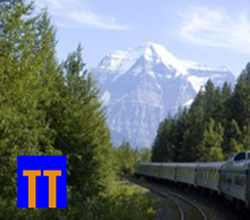Do As We Say, Not As We Do.
Let’s start with the fact that railroad tracks are private property. That’s why people walking on the tracks—ordinary folks, not railroad employees—are invariably referred to as “trespassers” by railroad personnel. Technically, that’s what they are, and by using the term, the railroads emphasize the point that the tracks are private property and “civilians” should stay the hell off!
 But none of us thinks much about walking on or across tracks, do we? Furthermore, I can’t state this as fact, but I’ll bet hard-core rail fans are among the worst offenders. After all, they KNOW all about trains, so they won’t do anything stupid.
But none of us thinks much about walking on or across tracks, do we? Furthermore, I can’t state this as fact, but I’ll bet hard-core rail fans are among the worst offenders. After all, they KNOW all about trains, so they won’t do anything stupid.
This is the cover of the August issue of TRAINS magazine, the bible for rail fans. The photo is of a CSX locomotive hauling the world famous Ringling Brothers and Barnum & Bailey circus train across a trestle in West Virginia.
It’s hard to see, but look to the right side of the front of the locomotive. Three men—apparently rail fans—no doubt there to get a last close-up look at this famous train and to take some photos. Sorry, but that’s just dumb . . . and I’m really surprised the magazine chose to run the photo.
Next—and I suppose this will forever mark me as a language pedant—I came across a news story yesterday about a “fatal collision” in Martinez, California, the other day, when an Amtrak train struck a pedestrian. I have no doubt it occurred, but I take exception to the use of the word “collision”. Please! Call it an accident or an incident or an occurrence or possibly even an event. But it was not a collision!



Hello, thanks for the sharing this blog, this is very helpfull for me , if you want any help regarding Mediation Services in UKthen contact with Legateca .
> But none of us thinks much about walking on or across tracks, do we?
Nope. First with the private property argument – did they buy the property? Or was it a gift from the state? Honestly, I view most RR-ROW as more akin to radio frequency; we [the people] gave it to them so they can provide [enormous] public benefit. We [the state] regulate its use and even its abandonment; the RR is not even permitted to walk away from the property without a process. None of that is very much like “private property”. Personally, I would **LOVE** for we [the people] to take all of it back, and tell the railroads they are a now a utility; which is what they are.
Second, as to walking on the the tracks – just as making a road safer or slower the answer is not a sign about the speed limit – it is to narrow and otherwise improve the road. The design matters. The question is why – aside from the railfan – people walk on the tracks. The answer, IMO, is honestly that they often provide the shortest and often SAFEST route between two points.
In my city our DOT rammed an interstate into the border between my neighborhood and the one to the south. If you want to walk from one neighborhood to the other you have a couple options. The first is an inclined five lane wide overpass, walking across a three lane off ramp, and a two lane on ramp. Or you can go down through the park and walk under the freeway on the RR tracks to a nice residential street. There are ~2 freight trains a day on those tracks, vs. the intersection at the freeway overpass which is rated a “high crash” intersection.
Of course the state wants to tell my neighbors that the first option is safer. I would love to have an Operation Lifesaver person come, look at this, and tell me to my face that people shouldn’t walk on the tracks.
Many of these situations aren’t about trespassing they are about the DOT, and cities, betraying their citizens. They are about the government’s sycophantic relationship with Motordom.
If there is a place where trespass is frequent the answer is not enforcement, it is to look at the place and ask “Why?”. Then @&*^*$@ fix it!
Aside: if it is private property when why do homeowners get cited about overgrowth and liter but the railroads are permitted to have what amounts to linear trash dumps?